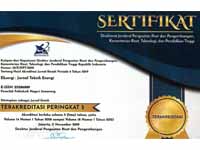Evaluation Of Refrigerating Load And Air Flow Performance In Air Conditioning Unit at Hospital Z
DOI:
https://doi.org/10.32497/eksergi.v19i01.4253Keywords:
Cooling load, cooling load temperature difference, external static pressure, fan coil unit, air conditioning systemAbstract
This research was conducted to evaluate air conditioning systems in pharmaceutical warehouses against the ANSI/ASHRAE/ASHE ventilation standards 170 ”“ 2008 and SNI-03-6572-2001. The method used is to calculate the cooling load on the FCU (Fan Coil Unit) using the CLTD (Cooling Load Temperature Difference) method and calculate the External Static Pressure on the ducting system. The analysis is carried out by comparing the results of calculating the FCU requirements with the actual specifications that have been implemented. Furthermore, the measurement results of the existing room air condition are compared with the standards for pharmaceutical warehouse applications. The calculation results show that the pharmaceutical warehouse has a cooling load of 47,472.72 Btu/hr, and has an external static pressure of 123 Pa. While the selected FCU (Fan Coil Unit) has a capacity of 78,771 Btu/hr and a maximum external static pressure of 130 Pa with a rated airflow of 4000 m3/hr. After 9 years of use, it is known that the rated airflow has decreased by around 37% of the FCU capacity. Existing room air conditions obtained the extreme temperature and RH of 23.36 °C and 72%, respectively.
References
W. F. Stoecker and W. J. Jerold, Refrigerasi dan
Pengkondisian Udara, Edisi kedua. terjemahan Supratman
Hara. 1987.
ASHRAE TC 9.6, HVAC Design Manual for Hospitals and
Clinics, Second Edition. 2013.
Standar Nasional Indonesia, “Tata Cara Perancangan Sistem
Ventilasi dan Pengkondisian Udara pada Bangunan
Gedung,” Sni 03 - 6572 - 2001, pp. 1”“55, 2001.
ASHRAE, “Fundamentals Handbook ASHRAE,” ASHRAE
Handb., 1997, [Online]. Available: http://www.ashrae.org.
L. Fitria, R. A. Wulandari, E. Hermawati, and D. Susanna,
“Kualitas udara dalam ruang perpustakaan universitas ”˜x”™
ditinjau dari kualitas biologi, fisik, dan kimiawi,” Makara
Kesehat., vol. 12, no. 2, pp. 77”“83, 2008.
ASHRAE GRP 158, Cooling and Heating Load Calculation
Manual. ASHRAE Inc, 1979.
A. Bhatia, “HVAC Cooling Load Calculations and
Principles,” vol. 318, 2012.
Carrier, Carrier handbook of air conditioning system design.
Mc Graw-Hill Inc, New York, 1965.
A. Bhatia, “HVAC - How to Size and Design Ducts,”
Contin. Educ. Dev. Inc., no. 877, p. 89, 2001
A. Bhatia, “HVAC Ducting - Principles and Fundamentals,”
vol. 246, p. 53, 2012, [Online]. Available:
www.PDHonline.org.
SMACNA, “Hvac Systems Duct Design, Third Edition,” in
Smacna, 1990
A. Vedavarz, HVAC : Handbook of Heating, Ventilation and
Air Conditioning for Design and Implementation. Industrial
Press Inc. New York, 2007
(BEE), “Energi Efficiency Guide Book,” Energy, vol. 5, pp.
”“112, 2004
A. Wahyudi B, “Modul Perkuliahan Audit Energi BAB 10
Kinerja, Efisiensi AC, dan Nilai IPLV,” Universitas Mercu
Buana, 2012, pp. 1”“23.
Marzuki, Achmad. "Audit Energi pada Bangunan Gedung
Direksi PT. Perkebunan Nusantara XIII (Persero)." Vokasi,
Volume 8, Nomor 3, Oktober 2012. hal 184 ”“ 196.
Purbaningrum, Sanurya Putri. "Audit energi dan analisis
peluang penghematan konsumsi energi listrik pada rumah
tangga." Jurnal Media Mesin, Vol. 15, No. 1, januari 2014,
hal. 26 ”“ 33
Purwito, Purwito, Tadjuddin Tadjuddin, and Akbar Akbar.
"Audit Energi dan Analisis Peluang Penghematan Energi di
PT. Daikin Air Conditioning Makassar." INTEK: Jurnal
Penelitian 5.2 (2018): 115-121.
Downloads
Published
Issue
Section
License
Authors who publish with this journal agree to the following terms:Authors retain copyright and grant the journal right of first publication with the work simultaneously licensed under a Creative Commons Attribution License that allows others to share the work with an acknowledgement of the work's authorship and initial publication in this journal.
Authors are able to enter into separate, additional contractual arrangements for the non-exclusive distribution of the journal's published version of the work (e.g., post it to an institutional repository or publish it in a book), with an acknowledgement of its initial publication in this journal.
Authors are permitted and encouraged to post their work online (e.g., in institutional repositories or on their website) prior to and during the submission process, as it can lead to productive exchanges, as well as earlier and greater citation of published work (See The Effect of Open Access).






